DfT gender pay gap 2018
Published 19 December 2018
Introduction
In 2017, the government introduced world-leading legislation that made it statutory for organisations with 250 or more employees to report annually on their gender pay gap. Government departments are covered by the Equality Act 2010 (Specific Duties and Public Authorities) Regulations 2017 which came into force on 31 March 2017. These regulations underpin the Public Sector Equality Duty and require relevant organisations to publish their gender pay gap by 30 March annually. This includes:
- the mean and median gender pay gaps
- the mean and median gender bonus gaps
- the proportion of men and women who received bonuses
- the proportions of male and female employees in each pay quartile
The gender pay gap shows the difference in the average pay between all men and women in a workforce. If a workforce has a particularly high gender pay gap, this can indicate there may be a number of issues to deal with, and the individual calculations may help to identify what those issues are.
The gender pay gap is different to equal pay. Equal pay deals with the pay differences between men and women who carry out the same jobs, similar jobs or work of equal value. It is unlawful to pay people unequally because they are a man or a woman.
The Department for Transport supports the fair treatment and reward of all staff irrespective of gender; and is committed to being a leader on inclusion in the Civil Service.
Building a diverse and inclusive workforce that reflects the people we serve is one of the Civil Service’s top workforce priorities. Our collective aim is to make the Civil Service the UK’s most inclusive employer by 2020. Our Diversity & Inclusion Strategy outlines how we plan to achieve this. The Civil Service should create opportunities for all in a truly meritocratic way and reward all civil servants fairly, regardless of gender, ethnicity or any other personal characteristic.
This report analyses our gender pay gap figures in more detail, makes comparisons with our 2017 data where relevant, and sets out what we are doing to close the gender pay gap in our department.
Reflections from our Permanent Secretary
The work of the Department for Transport and its agencies is extremely diverse. The activities our people are involved in include advising ministers on transport priorities for the country, delivering huge and complex infrastructure projects, providing a wide range of vital services to motorists and citizens across the country, and supporting maritime and aviation security across the world.
I am committed to addressing long-term gender imbalances right across the DfT family. So I’m disappointed that our mean gender pay gap remains high at 15.6% and I am determined my department is doing everything it should to narrow this gap.
However, I do not want to underplay the scale of this challenge, which is, in part, a function of DfT’s diverse make-up and history. For example, DVLA has always been a significant employer of women in Swansea, providing good jobs that are vital to the local economy, but often at relatively junior grades. At the same time, much of the DfT family offers jobs in technical professions that have all too often been seen as off-limits or unattractive to women. I want to see all the jobs offered in transport made open and equally attractive to men and women. But this will take time.
In the meantime, we are making progress in many areas where we do need to change and I am proud of the initiatives underway to address the gender pay gap.
In the last 12 months:
We have improved the diversity of our most senior leaders. In 2017/18, 43% of our Senior Civil Servants (SCS) are women compared to 37% a year earlier. This includes 4 directors general, plus 2 of our 4 agency chief executives.
We appointed our Directors General for Rail, Ruth Hannant and Polly Payne, as our Gender Champions. They are the first DG level job-share partnership in government and are a great example to others – showing that flexible working can work at all levels.
We have implemented the recommendations from our Harvard Business School review into improving gender diversity in our recruitment practices, particularly around the use of language in job adverts, and have seen an increase to over 4 times the number of female applicants to surveyors’ roles at the Maritime and Coastguard Agency.
Our staff networks have gone from strength to strength and continue to build our inclusive culture through innovative workshops and practical support for people right across DfT. In the last month, we have launched a charter to help managers support people who may be suffering from domestic abuse – an initiative started by our Gender Equality network.
In addition, DVLA, based in Swansea, has been recently awarded silver status in Chwarae Teg’s (a charity leading gender equality in Wales) FairPlay benchmark.
But we know we must do more. That is why we are working with the Government Equalities Office and The Behavioural Insights Team to understand what works in creating gender parity in organisations.
As government, we also need to do more to encourage women to extend their study in technical disciplines and then to embrace the careers in engineering and construction that are so important to the transport industry. I am particularly proud therefore, of my department’s work in leading a highly successful campaign across the economy to make 2018 the Year of Engineering, which includes the aim of inspiring women and girls to become our engineers of the future. Early results suggest this is helping many more children to consider engineering as a career.
Year of Engineering partners have collectively delivered more than 750,000 direct experiences of engineering for young people throughout the year so far, and as we work towards our target of one million experiences, we are already seeing an encouraging shift in perceptions of engineering careers among young people.
We also continue to work across the transport sector to build engineering and technical apprenticeships as part of the Transport Infrastructure Skills Strategy (TISS) launched in January 2016. The TISS sets out ambitions for at least 20% of new entrants to engineering apprenticeships in the transport sector to be women by 2020, and achieve parity within the working population by 2030.
I am absolutely committed to making DfT an inclusive, flexible and diverse organisation that gives women both the confidence and the environment in which they can progress and succeed. I am one of those women, and I believe that through our gender pay gap action plan and our range of initiatives to champion women in transport, we will make a difference in years to come.
Bernadette Kelly
Permanent Secretary
1. Who we are - the DfT family
DfT comprises a core ministerial department and 4 executive agencies. We have a diverse workforce, working across Britain in a wide range of roles, from policy developers to critical front-line services such as the air, marine and rail accident investigation branches, driving examiners, coastguards, engineers and marine surveyors. Across the department we have over 25 professions in a range of grades both in our Senior Civil Service and the grades below.
The DfT family consists of:
| Organsiation | Description | Number of staff |
|---|---|---|
| DfT Central | Provides policy guidance and roads funding to local authorities, investing in around 4,300 miles of motorway and trunk roads through Highways England. Also sets the strategic direction for the rail industry in England and Wales; supports low pollution transport modes; leads aviation policy and sets world leading safety standards for transport. Based primarily in London and Hastings. | 2,488 |
| The Driver and Vehicle Licensing Agency (DVLA) | Keeps complete records of drivers and vehicles and is responsible for Vehicle Excise Duty and helping to ensure the public is protected from uninsured vehicles and drivers. Headquarters in Swansea. | 5,975 |
| The Driver and Vehicle Standards Agency (DVSA) | Improves road safety by setting standards for driving and making sure road users follow them. Headquarters in Bristol with UK wide locations including driving test centres throughout the UK. | 4,710 |
| The Maritime and Coastguard Agency (MCA) | Facilitates international maritime trade and delivery of the government’s maritime safety strategy, security and safety standards. Headquarters in Southampton with operational sites across the UK coastline, with 3,500 volunteer coastguards supplementing the workforce. | 1,106 + 3,500 coastguards |
| Vehicle Certification Agency (VCA) | UK approval authority for new types of road vehicles, tractors and off-road vehicles. Provides testing and certification for vehicles. Headquarters in Bristol. | 170 |
The staff figures in this section are accurate at March 2018 and may vary from other staff data presented in this report.
Part of DfT Central:
- accident investigation branches - small highly specialised teams of accident investigators.
- Office for Low Emission Vehicles - works across government to support the introduction of ultra low emission vehicles.
- Government Car Service - provides a high quality secure car service for government ministers.
- Centre for Connected and Autonomous Vehicles - policy unit which ensures that the UK remains a world leader in developing and testing autonomous and connected vehicles. Joint with BEIS.
Fig 1. Collectively we have nearly 14,400 staff and 3,500 volunteer coastguards
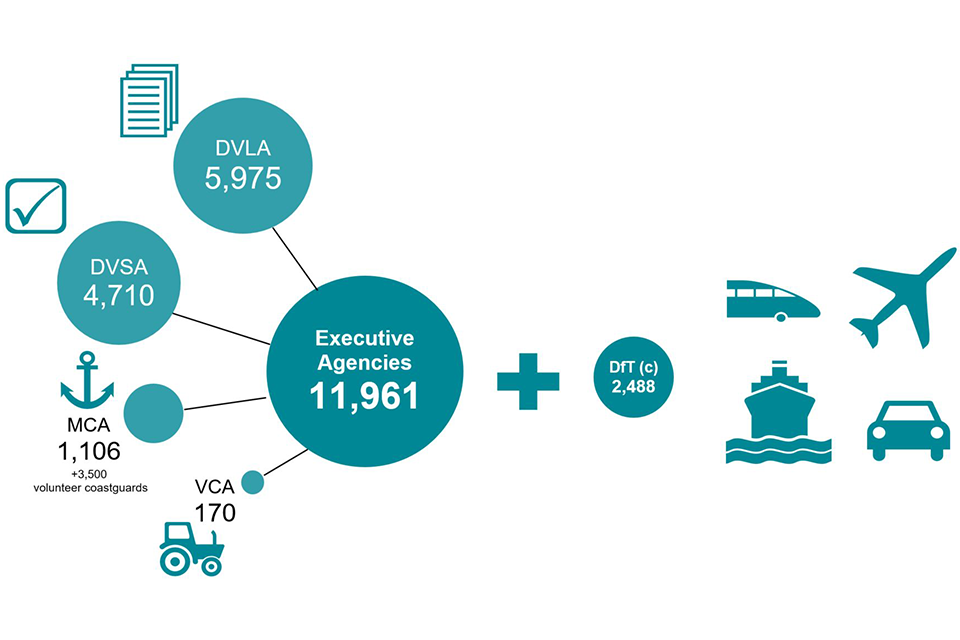
The DfT family is DfT central - 2,488 staff, includes the Accident Investigation Branches, OLEV and the Government Car Service plus the Executive Agencies (11,961 staff). DVLA (5,975 staff), DVSA (4,710) MCA (1,106) VCA (170).
2. Gender pay gap analysis
Gender pay gap
The gender pay gap shows the difference in average (mean and median) hourly pay between all men and women in a workforce. An hourly rate comparison is used to look at the pay gap because this takes into account part time workers.
Our departmental family mean gender pay gap has decreased by 1.3% since 2017, from 16.9% to 15.6%.
Our departmental family median gender pay gap has decreased by 7% since 2017 from 22.6% to 15.6%.
Fig 2. What are our gender pay gaps (hourly rate)?
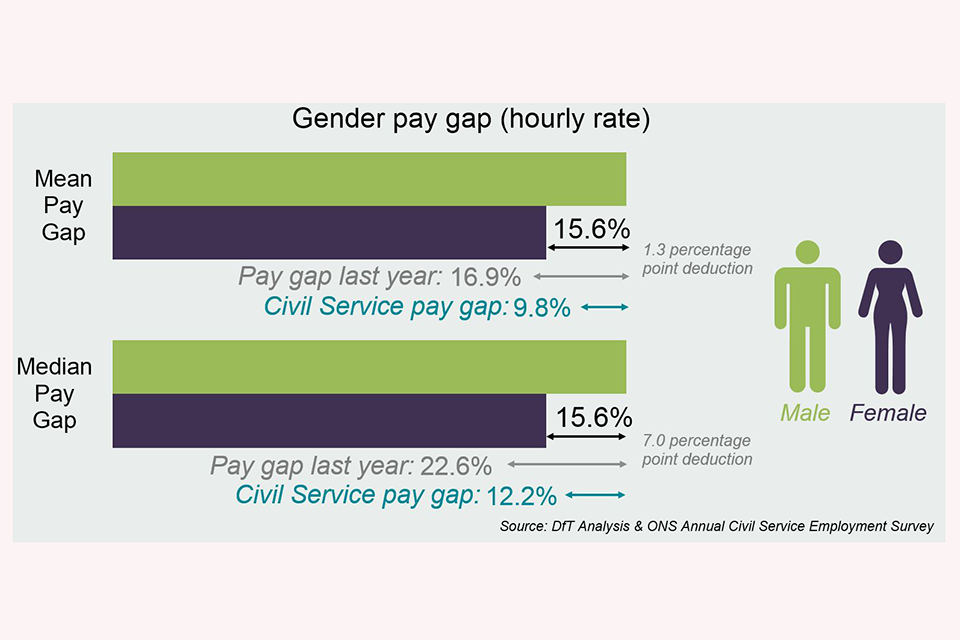
Hourly rate mean pay gap between male and female employees is 15.6%, which is a 1.3% reduction on last year. Hourly rate median pay gap between male and female employees is 15.6%, which is a 7.0% reduction.
Why do we still have a gender pay gap?
There are factors contributing to our gender pay gap:
Different levels of gender representation across all grades and across different locations.
Overall, the DfT family has an employee population made up of 44% women and 56% men. However, we have different levels of gender representation across all our grades, with higher levels of women at the lower grades. DVLA, who are the largest employer in DfT with just under 6,000 employees, have large numbers of women at lower grades. This brings the average hourly rate for women down. This population is also paid based on our national pay bands, which are lower than London pay bands to reflect the difference in living costs. The relatively high representation of women in our Senior Civil Service (43%) and on our board (71% of our executive are women) does not mitigate the gender imbalance across all grades in the DfT family.
Fig 3. Number of employees by grade, by gender - DfT and the agencies
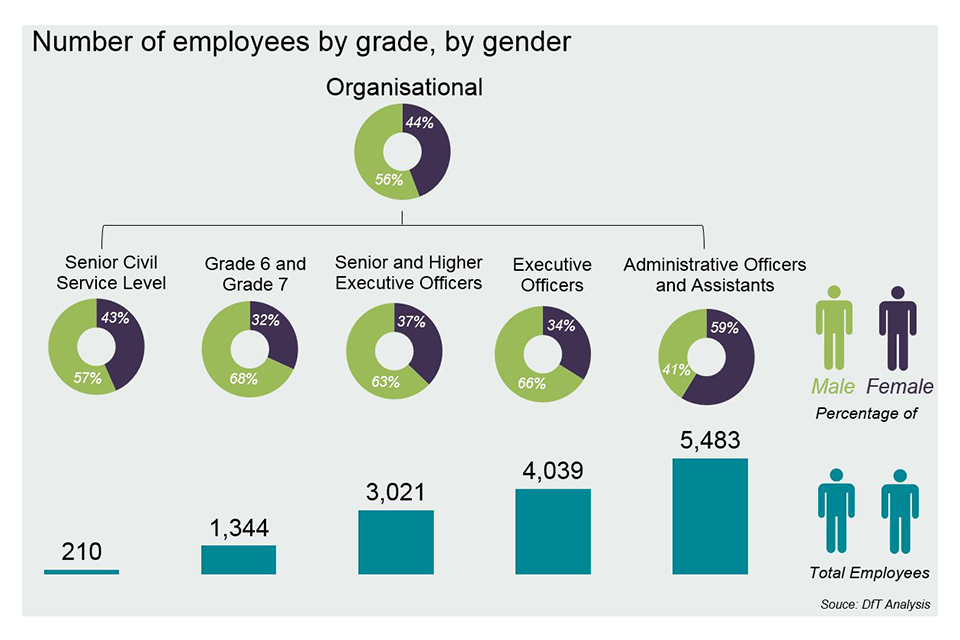
Number of staff broken down by grade and gender for DfT and its agencies. Overall 56% are male and 44% female. By grade the the chart shows males are most represented at grade 6 7 level with 68% and females at admin officer level with 59%.
High number of male-dominated specialist and technical roles.
Hourly rates used to calculate gender pay include retention and technical allowances that are paid to employees with specialist, technical skills and expertise. The workforces in DVSA, MCA and VCA demonstrate heavy skewing towards men in roles such as driving examiners, vehicle examiners and maritime surveyors. Most of these roles require technical qualifications, or prior experience as a mechanic, engineer, pilot or ship’s captain, which drives recruitment towards a narrow, mostly male pool - for example, 95% of engineers in VCA, 77% of driving examiners, 99% of vehicle examiners in DVSA and 96% of marine surveyors in MCA. Many of these roles also attract additional allowances due to market shortages, unsociable working hours or travel. These roles reflect a wider pattern across the transport sector.
Fig 4. What are the proportions of male and female employees in each quartile?

Proportion of male and female employees in each pay quartile. Upper pay quartile = 66.6% male, 33.4% female. Third quartile = 71.3% male, 28.7% female. Second quartile = 51.5% male, 48.5% female, lower quartile = 33.8% male, 66.2% female.
Gender bonus gap
The mean bonus payment gap has decreased by 1%, from 25.2% to 24.2%
The median bonus payment gap has decreased by 3.9% from 22.22% to 18.3%
Fig 5. What are our gender bonus gaps?
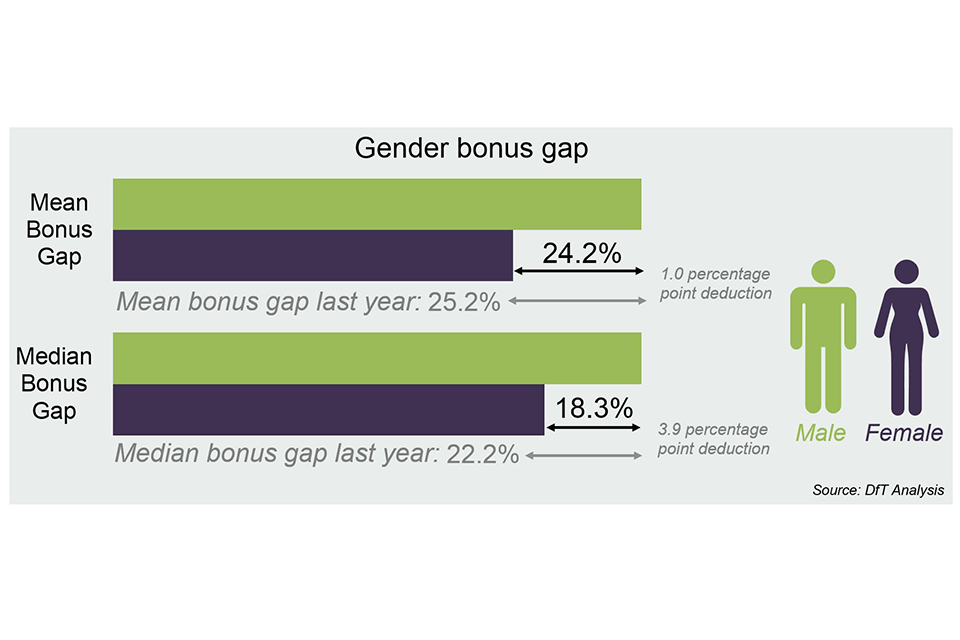
The mean bonus gap payment between male and female employees in DfT and its agencies is 24.2% which is a 1.0% reduction on last year. The median bonus payment gap between male and female employees is 18.3% which is a 3.9% reduction.
However, 70% of women in DfT received a bonus payment in the last 12 months.
Fig 6. What proportions of male and female employees received a bonus?
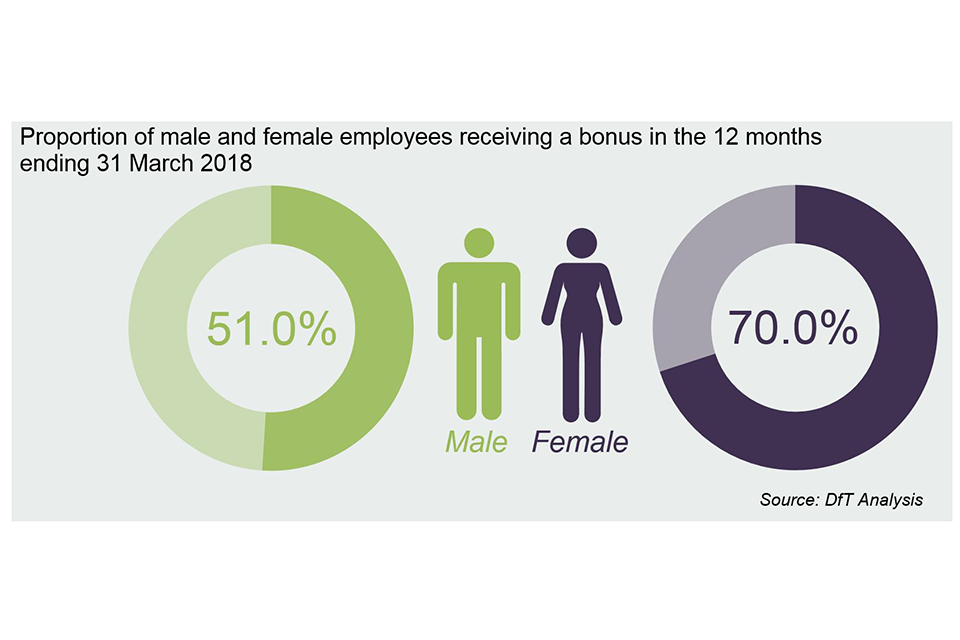
The proportion of male and female employees in DfT and its agencies who received a bonus in the 12 months ending 31 March 2018 were 51% of male employees and 70% of female employees.
To understand why the bonus gap exists, we need to note that:
Non-consolidated end year bonus payments are pro-rated in accordance with the number of hours worked. As a result, people working part-time, of whom the majority in DfT are women, will receive a lower bonus when compared to full-time employees.
The value of our non-consolidated bonuses increases with seniority of grade. There is a greater representation of male employees in the more senior grades, so the average bonus for men will be higher than that for women.
Why is the bonus gap larger than the pay gap?
The bonus pay gap does not use an hourly rate, and therefore is affected by the larger number of female part-time workers who would get a smaller bonus due to working fewer hours.
3. Diversity and inclusion at DfT
At DfT, we recognise the importance of having a truly diverse workforce and an inclusive culture not only because it is the right thing to do but because we need to both reflect the public we serve and draw on the biggest talent pool possible to achieve the significant transport opportunities that lie ahead.
We published our diversity and inclusion strategy, Different People. One Team in 2017 in parallel with the diversity and inclusion strategy for the Civil Service. Our strategy is based on 5 goals with associated outcomes that we want to achieve by 2021:
- We are one of the most inclusive departments in the Civil Service.
- We attract, recognise and nurture diverse talent.
- We better reflect local working populations in all grades, roles and professions.
- Our staff networks are amongst the best in the Civil Service and transport sector.
- We understand the importance of diversity and inclusion and how we all play a part in making it happen.
Each of these broader themes, has a role to play in closing the gender pay gap as well as creating an inclusive environment for our people – current and future.
Our D&I strategy also specifies some gender related outcomes which we have committed to:
- making progress towards gender parity in all grades and locations
- strengthening our female talent pipeline (grades 6 & 7) and senior leadership cadre
- increasing the number of women in roles and professions where they are underrepresented
These also inform our approach to closing the gender pay gap in section 4.
4. Closing the gap
Our gender pay gap plans are overseen and challenged by our group people committee. Our gender champions, Ruth Hannant and Polly Payne are the first Director General job-share partnership in government. They support our dynamic and influential gender network and are role models for our commitment to flexible working across all levels.
We have already taken action, including:
- using gender balanced selection panels - an expectation in our recruitment strategy
- name-blind sifting for all recruitment campaigns (including for the SCS)
- using specialist technology to screen job adverts and candidate packs to ensure we are using inclusive language
- leading the way in the Civil Service by using strengths based interviewing (focusing on potential rather than previous track record)
- putting into practice what we have learnt from our collaboration with Harvard Business School in 2017 to understand how to improve gender diversity in our recruitment processes - this includes showcasing women’s success stories to attract more women into traditionally male roles and using social media more effectively
- recruitment changes implemented by MCA have led to a 4-fold increase in female surveyor applications in the 2 years following our collaboration with Harvard Business School
- increasing our proportion of women in Senior Civil Service roles from 37% in 2017 to 43% in 2018
- successfully recruiting our first female IT apprentices in DVLA
- appointing 2 women in specialist engineering roles (Type Approval Engineers) in VCA in 2018
- holding open days with HM Coastguard for all potential applicants - this has helped MCA to combat some of the perceptions that may be deterring women from applying
- establishing a small Digital and Technology recruitment team focused on proactively sourcing a diverse set of digital candidates
- working across the transport sector to build engineering and technical skills for the future through the Transport Infrastructure Skills Strategy with the ambition that women should make up 20% of new engineering apprenticeships by 2020 - achieving parity with the working population by 2030
- leading the 2018 Year of Engineering to encourage women and girls to consider a career in engineering
Going forward we want to do more. Recent research by the Government Equalities Office (GEO) and the Behavioural Insights Team (BIT) has focused on evidence based actions, tested in the real world, to help employers improve gender equality practices in the workplace. The research focuses on improving outcomes for women by scrutinising bias in recruitment, pay and progression, and emphasising the importance of flexible working, networking, and sponsorship on women’s progression in the workplace.
Using this emerging research, and following consultation with our gender staff networks and our senior leaders, we will develop specific gender pay gap action plans for each DfT organisation, focusing on 3 broad themes:
- recruitment and attraction
- supporting women to develop and progress
- minimising the impact of the ‘family penalty’ and creating a culture where women can thrive
Specific future actions will include:
Implementing the recommendations from the Clear Company review of DfT’s recruitment approach (due by December 2018) to improve women’s experience throughout the recruitment and selection process.
DVSA linking with universities, their feeder schools and FE colleges who have signed up to the Athena Swan Charter, which champions the advancement of women in science, technology, engineering and maths (STEM).
VCA launching an engineering apprenticeship starting at level 3 but giving apprentices scope to qualify as Chartered Engineers . VCA want to attract a diverse pool of applicants with a strong focus on encouraging women to apply.
DVLA running an annual ‘Code Challenge’ with over 50 local schools and community groups; and now increasing its outreach to 7-11 year old children as well as 11 to 14 year old pupils, to encourage both boys and girls to take up an IT career. The challenge will encourage pupils to develop their problem solving, communication and teamwork skills through computer programming projects.
MCA will continue to work with the maritime sector to encourage more women to consider careers in maritime and coastguard professions.
Appointing a “sourcer” to our Digital and Technology recruitment team who will be responsible for attracting more women into our Digital and Technology profession.
Launching a new sponsorship programme for women focusing on the feeder grades to the Senior Civil Service. Sponsors will act as advocates for individuals, and will provide them access to networks.
Continuing to build our inclusive culture by introducing staff-led ‘Fair Treatment Ambassadors’ in the central department who will help all our people, including women, feel welcome, able to be themselves and safe to challenge unacceptable behaviours.
Reducing the ‘family penalty’ by better supporting people returning from maternity leave; encouraging take up of shared parental leave and supporting carers.
5. Conclusion
We welcome the spotlight that gender pay gap reporting shines on the progress of women in the workplace and we want to make a sustainable difference over the longer term. We will continue to review and amend our plans and will share our ideas and learn from others, both in and outside our sector, to achieve the best outcome for our people, and the people we serve.
Declaration
I confirm that data reported by the Department for Transport is accurate and has been calculated according to the requirements and methodology set out in the Equality Act 2010 (Specific Duties and Public Authorities) Regulations 2017.
DfT Permanent Secretary Bernadette Kelly
